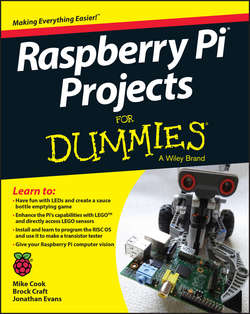Читать книгу Raspberry Pi Projects For Dummies - Evans Jonathan - Страница 12
На сайте Литреса книга снята с продажи.
Part I
Getting Started with Raspberry Pi Projects
Chapter 1
Getting to Know the Raspberry Pi
Connecting Your Hardware
ОглавлениеWhen you’ve got the essential accessories and the operating system, you can set up your hardware. This is simply a matter of connecting the right bits together. Figure 1-5 shows you how things are connected using a Raspberry Pi Model B.
Figure 1-5: Hooking up all the hardware.
Follow these steps to set up your hardware:
1. Locate the SD card slot on the bottom of your Raspberry Pi and insert the newly flashed SD card snugly, with the label facing down.
The card will stick out from the side of the circuit board a little bit.
2. Connect your computer monitor or TV to your Raspberry Pi.
If you’re using a monitor or TV with an HDMI connection, just connect the two with an HDMI cable. If your monitor has a DVI connection instead, insert the HDMI cable into an HDMI-to-DVI adapter and then plug it into your monitor. If you’re using a TV without an HDMI connection, connect a yellow RCA connector cable to the round RCA jack on the top of your Raspberry Pi and plug the other end into your TV’s composite video input.
You may need to manually select which input your monitor or TV is using. Check the manual if you aren’t sure how to do this. Also, make sure the power to your display is switched on.
3. Connect your USB hub into one of the two USB sockets on the right side of your Raspberry Pi.
If you’re using a Raspberry Pi Model A, there will be only one socket. Your hub should have a power adapter – plug it into an electrical socket.
4. Plug your keyboard and mouse into the USB hub.
If you’re using a keyboard or a mouse with an older PS/2-style connector, you’ll need a PS/2-to-USB adapter. You can also connect them directly to your Raspberry Pi’s remaining USB socket, but it’s a good idea to use the hub, which has more available power.
5. Connect your audio.
If you’re using an HDMI monitor with audio, the audio will go through your HDMI cable. If you’re using external speakers or a TV, your audio output is the black 3.5mm socket on the top-right edge of your Raspberry Pi. Connect your speaker cable there.
6. Connect to your network.
If you’re using a Model A, you can skip this step. There is no network connection available for it.
If you’re using a Model B, connect an Ethernet cable to your Ethernet socket on the right side of the board. When your operating systems starts up, it will automatically connect to your home router, as long as it supports Dynamic Host Configuration Protocol (DHCP). (Most home routers do.) If you have trouble connecting to the network, see your Internet service provider’s instructions for setting up new devices using DHCP on your home router. In rare cases, DHCP may be switched off.
7. Connect your micro USB power supply to your power socket on the bottom-left corner of your board.
Some power supplies have standard-size USB ports. You connect a USB–to–micro USB adapter cable from the standard USB output on these power adaptors to the micro USB input on your Raspberry Pi. There is no power switch. To cycle the power, you remove the adapter plug and put it back in, which is a little awkward. If you have an extension lead with a switch, you can connect your power adapter and use the switch on the lead to cycle to turn the power on and off more easily.
Don’t connect your Raspberry Pi to your computer’s USB port via a USB–to–micro USB adapter cable. Your computer’s USB port isn’t designed to deliver enough power for your Raspberry Pi, via the USB port.
When you power up your Raspberry Pi you should briefly see a rainbow-colored screen, which confirms that the hardware itself is working. Then the Linux operating system on your SD card will start to run and you’ll see an avalanche of text on your screen as all the various parts of the system are started. It can be pretty fun to watch. This will take a little time to complete. When it’s finished, you’ll be able to move on to setting up the system in the next section.
You’ll also see a little status light on the board next to the audio jack. The PWR light should be on. When your Raspberry Pi accesses the SD card to load the operating system, you’ll see the ACT light activated.
If you’re using an earlier Revision 1.0 board, the ACT light is labeled OK.
The FDX light indicates that you have a good Ethernet connection. The LNK light will flash whenever there is network traffic on the wire. The 100 light indicates a high-speed (100 Mbit) Ethernet connection.
